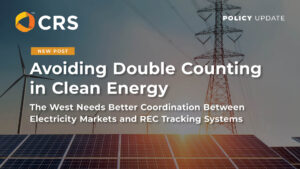As more Western states ramp up their clean energy programs, the way we account for renewable energy and emissions is changing. Recently, two major electricity market operators for the Western region, the California Independent System Operator (CAISO) and the Southwest Power Pool (SPP), have been exploring new frameworks for tracking and allocating energy and emissions to consumers. Their goals are to ensure that each state or utility knows what energy and associated emissions it’s getting from the market. But there’s a problem: these new systems could unintentionally lead to “double counting” of renewable energy across the region. Double counting undermines the credibility of state and voluntary programs and can distort progress toward greenhouse gas (GHG) reduction goals.
In the West and across the country, renewable energy certificates (RECs) are the standard instrument for verifying renewable energy use on the shared electric grid. A REC represents one megawatt-hour of renewable generation, and states and utilities use RECs to prove they are meeting renewable energy usage and certain emissions reduction targets. WREGIS (the Western Renewable Energy Generation Information System) is a registry that tracks these certificates. RECs can be bought and sold separately from the actual power, which means that renewable energy can be credited toward consumption at the state, utility, or individual customer-level as long as it has the REC.
Now, CAISO and SPP are introducing new mechanisms and frameworks to “attribute” and “allocate” electricity generation and emissions to certain states or load-serving entities (LSEs), e.g., utilities. Their approach is to assign generation based on in-market optimization mechanisms and new out-of-market accounting frameworks without always involving RECs for renewable generation. This process is intended to help utilities meet state-specific clean energy requirements more easily, but because these markets assign renewable energy to electricity consumption without using the WREGIS REC system, the same renewable energy could be counted twice — once by the state or LSE where the renewable energy is deemed to be used by the market and again by the state or utility that holds the REC.
For example, a wind farm in Wyoming might generate electricity that CAISO attributes to California, which avoids an emissions compliance obligation in California, while the REC from that same energy is sold to a utility in Colorado, which reports to its customers that they are receiving zero-emissions electricity. Both California and Colorado would then be claiming the same renewable energy, even though it was only generated once. This duplication could lead to inaccurate reports on emissions reductions, misleading both policymakers and the public about progress toward clean energy goals.
This issue is particularly pressing because many Western states rely on RECs to track compliance with their Renewable Portfolio Standards (RPS) — programs that require utilities to provide a certain amount of their electricity from renewable sources. Double-counting risks throwing off RPS targets and other programs like California’s Low Carbon Fuel Standard or Washington’s Clean Energy Transformation Act, which both rely on accurate emissions reporting. In addition, double counting RECs could jeopardize their eligibility for federal programs and subsidies, like the Inflation Reduction Act (IRA) 45V hydrogen production tax credit. Without a clear and consistent system for tracking renewable energy and associated emissions across multiple jurisdictions, states and federal programs risk regulatory confusion and reduced program credibility.
So, what’s the solution? Coordination between these new market frameworks and REC systems, namely WREGIS, is essential. If market allocation data is shared with WREGIS, states and voluntary clean energy programs can ensure that renewable energy allocations match the REC-based system already in place. This alignment would give states a consistent and reliable view of clean energy use and ensure that retail clean energy and GHG claims are exclusive and real. Market operators should also require LSEs to hold RECs for any renewable energy and associated emissions they claim through market allocation. This would protect the integrity of REC-based programs while still allowing for new market allocation approaches to meet state requirements.
Western states are taking ambitious steps to transition to clean energy, and they need accurate data to measure their success. Avoiding double counting is a simple but vital step toward a transparent, effective, and trusted clean energy system that delivers on its promises to reduce emissions and promote sustainability. By aligning REC systems with new market allocation frameworks, states can maintain clear accountability and keep their clean energy targets on track.
More information is available in this Background Report: GHG Allocation and RECs in Western Markets.
